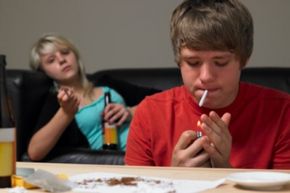 “Alcohol and drug use in teens is a factor in teen car crashes, property damage, early sexual intercourse and STDs. See more drug pictures.iStockphoto/Thinkstock
“Alcohol and drug use in teens is a factor in teen car crashes, property damage, early sexual intercourse and STDs. See more drug pictures.iStockphoto/Thinkstock
Many people first try alcohol during their teenage years. The average age for girls is 13-years-old, according to studies by the CDC and the American Academy of Pediatrics (AAP). It is the drug most often used by 12- to 17-year-olds, with more than four million adolescents drinking alcohol in any month. In a recent survey, 25 percent of 8th graders, 40 percent of 10th graders and 53 percent of 12th graders reported drinking alcohol during the prior month.
Although most parents think peer pressure is the main reason teenagers drink, 79 percent of teens say they drink to get drunk or because it "feels good;" 67 percent say drinking alcohol helps them forget their problems; and 66 percent say peer pressure is the reason. Forty-seven percent say they drink because they have nothing better to do.
The prevalence of alcohol use among teens mixed with the effects of alcohol — a tendency toward risky and violent behavior, impaired judgment and slowed reaction time — help explain why alcohol is a major factor in teen motor vehicle crashes, homicides, suicides and drowning. Its use is also linked to early sexual intercourse, date and acquaintance rapes, unplanned pregnancies, sexually transmitted diseases, fights and community property damage. In addition, many young people also die from alcohol poisoning.
Binge drinking (consumption of four or more drinks on a single occasion within the past two weeks) is a major problem in our college campuses. It is binge drinking, as opposed to drinking in general, that causes most of the alcohol-associated harm occurring on our campuses and in students’ lives. A major, eight-year study (the 2001 Harvard School of Public Health College Alcohol Study) involving the drinking habits of thousands of college students recently reported their findings in the Journal of American College Health. Results of the study revealed that, in 2001, approximately two in five (44.4 percent) college students engaged in binge drinking, a rate almost identical to rates reported in the previous eight years. Among the underage students, half of those surveyed reported obtaining alcohol easily; other students are their primary source. But since 1993, the use of fake identification cards to obtain alcohol illegally has declined, whereas the role of parents as providers of alcohol to underage students has increased. In addition, a sharp rise (from 5.3 percent in 1993 to 11.9 percent in 2001) in frequent binge drinking was noted among women attending all-women’s colleges, and a lesser, but still significant, increase of the same behavior for women in coeducational schools.
These findings, and others revealed that, despite efforts to curb binge drinking on our campuses through alcohol-prevention programs, services, activities and policies, there is still much more that needs to be done.
See the next page to learn about teen drug use.
Teen Drug Use
In 1999, nearly half of all high school students had used marijuana, the most commonly used illicit drug. More than 25 percent used it more than once in the last month.
The National Institute on Drug Abuse, an agency of the National Institutes of Health, reports the use of the drug Ecstasy and steroids is on the rise. In 1999, the percentage of 12th graders who had used Ecstasy increased to eight percent, up from 5.8 percent. The percentage of 10th graders who had ever used anabolic-androgenic steroids increased from two percent in 1998 to 2.7 percent in 1999 and the percentage of eighth graders who had used them was up to 1.7 percent from 1.2 percent the year before. Inhalants are the next most widely used drug, followed by cocaine, LSD and heroin.
Alcohol and drug use is prevalent among teens, as these studies and figures point out. Any alcohol or other drug use can be a slippery slope, imperiling not only your health and safety but also the health and safety of others (visit the Substance Abuse topic at this Web site for risk factors associated with alcohol and drug use.) Recognizing this, it’s important for teens to plan alternate social activities that do not involve drinking. More and more high schools and colleges are lending their support to these efforts by planning events that alleviate weekend boredom and give teens an alternative to traditional high-risk events, such as school-based post-prom parties.
For more information about teens and substance abuse, see the links on the next page.
Lots More Information
Related Articles
- Crack Cocaine Quiz
- Teens and Alcoholism
- Troubled Teen Quiz
- How Meth Works
- How Marijuana Works
- How Alcoholism Works


